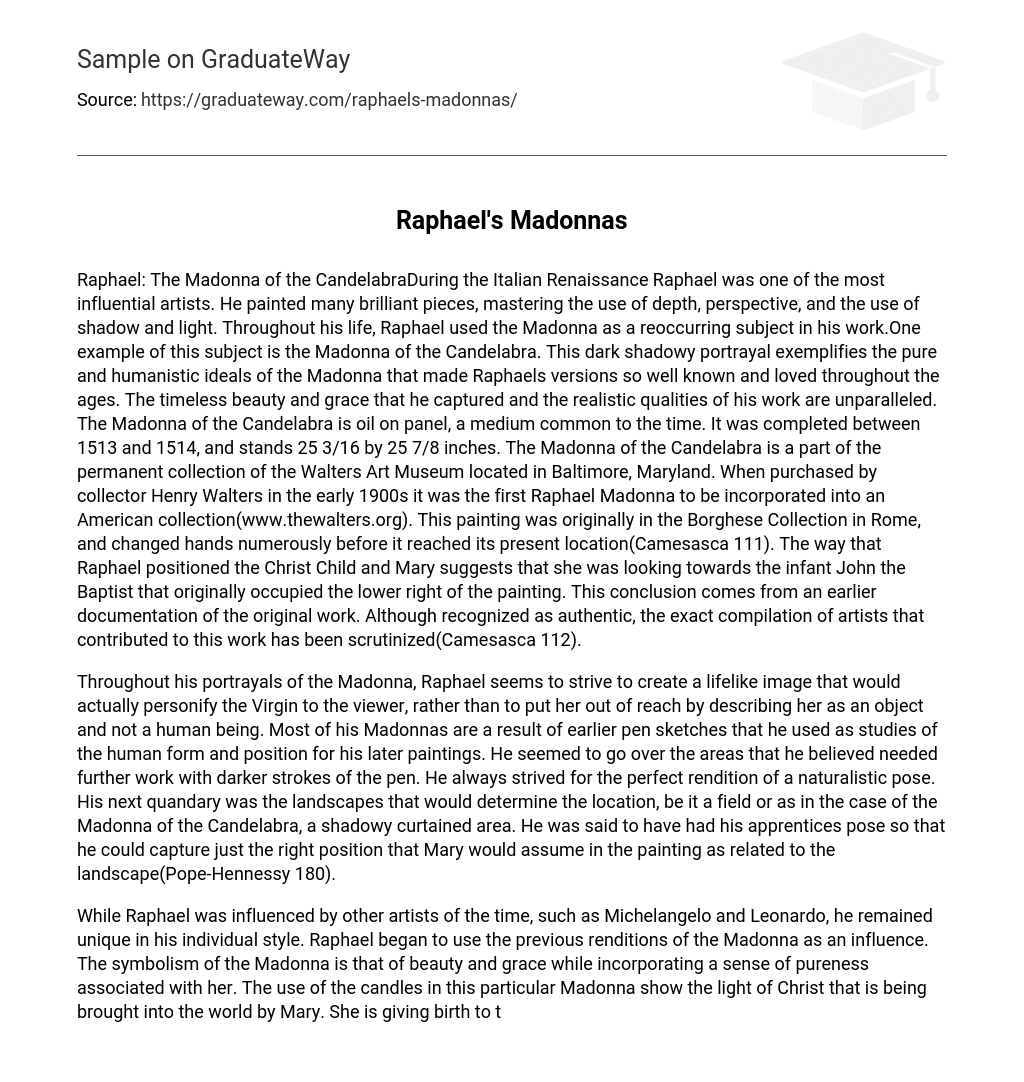Raphael, one of the most influential artists during the Italian Renaissance, skillfully utilized depth, perspective, and the interplay of shadow and light in his brilliant paintings. Throughout his career, he frequently depicted the Madonna as a reoccurring subject. One example of this is the Madonna of the Candelabra, a dark and shadowy portrayal that exemplifies the pure and humanistic ideals associated with the Madonna. This masterpiece, renowned and beloved for its timeless beauty and realistic qualities, was created using oil on panel, a popular medium of the time. Completed between 1513 and 1514, the painting measures 25 3/16 by 25 7/8 inches and currently resides in the Walters Art Museum in Baltimore, Maryland. Originally part of the Borghese Collection in Rome, this exquisite artwork has changed hands several times before finding its way to its present location. The positioning of the Christ Child and Mary suggests that Mary was gazing towards the infant John the Baptist, who originally occupied the lower right section of the painting. Evidence supporting this conclusion comes from earlier documentation of the original work (www.thewalters.org).The authenticity of this work has been examined and although it is acknowledged, there has been scrutiny regarding the precise group of artists who contributed to it (Camesasca 112).
Raphael’s portrayals of the Madonna aim to create a lifelike image that personifies her to the viewer, rather than objectifying her. Many of his Madonnas are based on pen sketches used as studies for later paintings. He would go over areas to be improved with darker pen strokes. His goal was to achieve a perfect naturalistic pose. Determining the landscape was his next challenge – whether it be a field or a shadowy curtained area like in the Madonna of the Candelabra. He had his apprentices pose to capture the exact position Mary would assume in relation to the landscape (Pope-Hennessy 180).
While influenced by artists such as Michelangelo and Leonardo, Raphael maintained his unique style. He drew inspiration from previous depictions of the Madonna, symbolizing beauty, grace, and purity. The lit candles in this painting represent the light of Christ brought into the world by Mary. As per Christian belief, Mary gives birth to the light of the world. The halos around Mary’s and Christ’s heads enhance the sense of holiness intended in the artwork. The other figures are portrayed as angels, overseeing the mother and child like a shepherd watches over his sheep. The painting is titled Madonna of the Candelabra due to the presence of the glowing candles in the background. Interestingly, Raphael did not typically name his works; their names were assigned over time to distinguish them from his other Madonna paintings.
Raphael painted multiple Madonnas with varying schematics. However, the Madonna of the Candelabra shares many similarities with other paintings from that period. When compared to the Madonna of the Fish, the resemblances become apparent. Both versions include additional characters, such as the Archangel and young Tobias in the Madonna of the Fish, or the two angel-like characters in the Madonna of the Candelabra. These supporting characters display adoration, respect, and nervousness as they approach the Virgin’s throne. Moreover, in both works and most other Madonnas, the Virgin does not directly gaze at the infant. Instead, her eyes cast downward, as seen in both the Madonnas of the Candelabra and the Fish. Stylistically, however, the Madonna of the Fish possesses more depth and intricate detail than what is visible in the cropped version. This distinction can be attributed to how the Madonna of the Candelabra has been transformed into a circular shape, potentially removing another character like John the Baptist, as previously mentioned.
Although Raphael’s life was short, he created some of the most beloved paintings that have stood the test of time. His unique ability to portray The Madonna in such an intimate and lifelike manner is unparalleled. No artist since then has been able to capture her essence and authenticity in the same way.
Works CitedCamesasca, Ettore. All The Paintings of Raphael. New York: Hawthorn Books,INC,1963.
Pope-Hennessy, John. Raphael. New York University Press, 1970.
The website www.thewalters.org was created in 2002. It contains 935 words and 24 pages.





